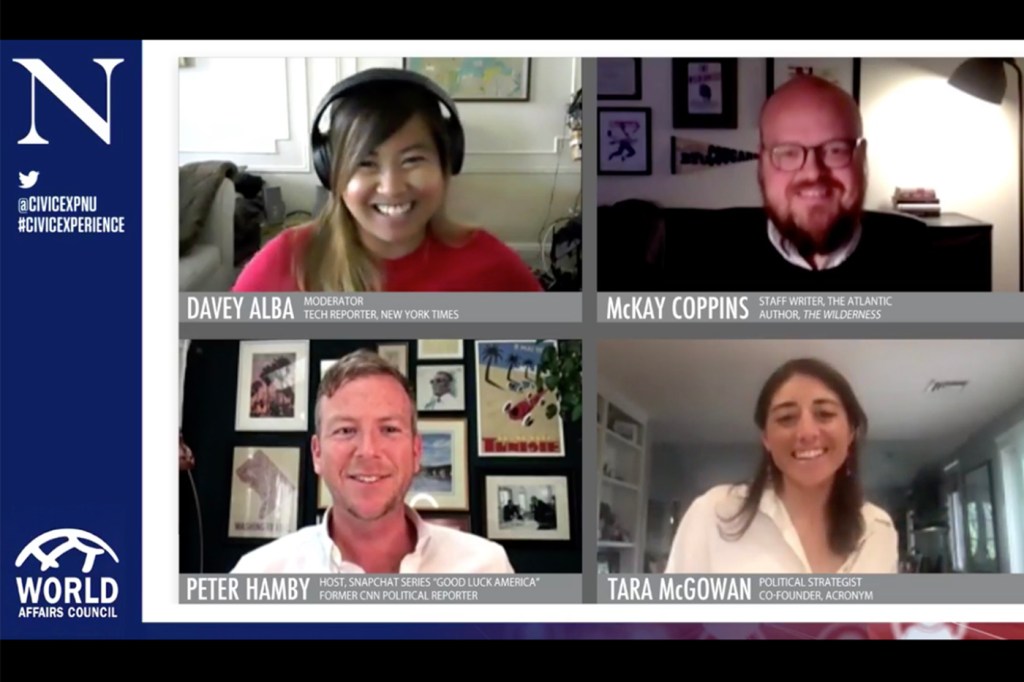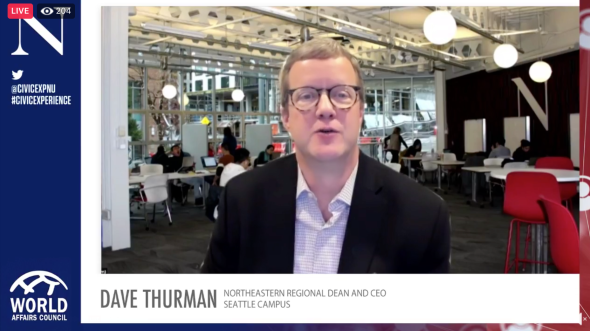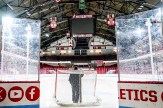Fake news vs. factual news: Think twice about what’s in your feed

If a news story pops up in your social feed and it has hundreds of likes, does that mean the article is true or just popular? Sometimes it’s hard to tell the difference.
It is growing increasingly difficult because of how digital platforms like Facebook and Twitter have supplanted National Public Radio and the tried and trusted evening newscast as the vanguards of journalism, ushering a new definition of what constitutes news, said a panel of current and former news reporters in a livestream hosted by Northeastern University and the World Affairs Council.

Dave Thurman is the regional chief executive officer and dean of the Seattle campus. Screenshot by Northeastern University
Tara McGowan, who left journalism to engage in the hand-to-hand combat of Democratic politics as a digital strategist, explained the nation’s political tribalism as a byproduct of the quick and easy convenience of social channels, which can be read anytime and anywhere on a phone, in turn making people more susceptible to the conspiracy theories and misinformation that abound on the Internet.
“Voters are busy, they have multiple jobs, they have families,” she said. “They’re no longer turning on the news at night or listening to NPR in the morning.”
In some instances, they’re not turning on the local news because small media outlets are disappearing.
“As somebody who believes in truth and democracy, I really believe that it is one of the most serious threats to our democracy that local news is disappearing in this country,” McGowan said. In their place, people are turning to alternative sources for information.
The result, said Davey Alba who is a reporter for The New York Times, are voters that constantly check their Facebook feeds for news and, in the process, gradually become more detached from reality.
Alba should know about conspiracy theories. Her beat is covering online disinformation, so she is aware of how quickly things can get out of control when unsubstantiated rumors ping around the Internet. One of her recent stories examined the false rumors that antifascist activists were responsible for the West Coast wildfires.
Part of what gave the story authenticity, said panelist and former CNN political reporter Peter Hamby, was that it was being shared by people with blue check marks on their Twitter accounts.
“A lot of authority figures, a lot of people with the blue check on Twitter, are actually just lying,” said Hamby, who hosts a political program, Good Luck America, on Snapchat.
The photo-sharing app, one of the world’s most popular social media platforms, positions itself apart from its competitors because of a business model where it acts as curators of content rather than amplifying content based on an algorithm to generate revenue.
“That has allowed us to create something of a walled garden for our content,” explained Hamby. “We make sure it’s trusted, safe, and credible before we move it to our platform.”
Most of his two million listeners are under the age of 25 and do not engage with traditional media content, a situation the company looks to fix.
“We’re partnering with news organizations like The New York Times, like The Wall Street Journal, like NBC News, like ESPN, in addition to having entertaining reality shows and makeup tutorials,” Hamby said.
Even still, those big names of journalism can sense their influence waning.
“There is a kind of a paranoia and almost like a neurosis within the media about our shrinking role and our shrinking status as gatekeepers,” said McKay Coppins, staff writer for The Atlantic.
Coppins, who authored a story earlier in the year critical of the presidential re-election campaign’s digital tactics, said the press has gotten better at spotting disinformation and recognizing the weight and importance of conspiracy theories that at first seem silly but are proliferating online.
“There used to be this idea that we, as the sterling and responsible gatekeepers in the mainstream media, shouldn’t dignify silly things,” Coppins said.
But that mindset changed when some politicians who espoused out-of-the-mainstream ideas wound up getting elected, prompting a re-think by the media on confronting theories that find a comfortable home in the anonymity of social media.
“We can’t just ignore these crazy ideas and lies that are metastasizing online because if they gain enough adherents, they can do that with or without us in the media,” Coppins said.
So how is someone supposed to guess the real from the fake?
Hamby, who serves on an advisory board of an organization that sorts fact from fiction, floated an idea he calls “lateral reading.”
“If you see something online that stirs passion, rage, or anger. or frustration, there’s a chance that that piece of content is designed to do just that,” Hamby said.
He advises researching the content in question and looking for an article about it from an established list of 20 or so credible news organizations such as NBC, ABC, CBS, USA Today, The Associated Press, and Reuters.
For media inquiries, please contact media@northeastern.edu.





